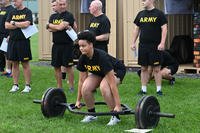If you have ever considered making regularly scheduled changes to your training, you should try the seasonal approach. This system of training, called Seasonal Tactical Fitness Periodization, is something I have been doing and teaching for more than 20 years. This process has led to a significant reduction in training injuries, improved performance in tactical programs by reducing weaknesses, and added variety to training so people stay more engaged throughout the year.
As part of a tactical periodization methodology, we incorporate regularly scheduled assessments into the training cycles. Toward the end of a cycle, assessing how your training focuses on the previous cycle's events is wise. The assessment will tell you: Do you need more time in the cycle, or are you ready to move on to the next training cycle?
We call our End of Summer-Beginning of Fall assessment the Tactical Groundhog Test. Depending on your performance during the assessment week, the cycle extends for another four weeks, or you move into the fall training cycle.
Our summer cycle focuses more on increasing endurance in running, swimming and rucking, and muscle stamina in high-repetition fitness tests. The fall cycle will decrease the running miles per week (increasing the speed) and increase the weight to reduce higher repetitions to build more strength. The winter cycle is a full lift cycle with strength/power and weight gain as the primary focus, but the cardio maintenance makes a tactical strength cycle different from your typical power lift/strength training cycle.
Remember, a tactical athlete needs to be good at all of the elements of fitness, not great at a few and weak at others. These include strength, power, speed, agility, endurance (run, swim, ruck), muscle stamina, flexibility, mobility and grip.
Here is a two-day test that assesses much of the summer training, as well as a precursor for the upcoming lift cycle:
Day 1: The Spec Ops Triathlon
- Four-mile run
- Four-mile ruck (40 pounds)
- One-mile swim with fins
Day 2: The Navy Physical Screening Test (PST), for instance, or whatever your standard fitness test is. The numbers inside the parentheses are recommended times or repetitions.
- Swim 500 yards (less than nine minutes)
- Push-ups two minutes (80+)
- Sit-ups two minutes (80+)
- Pull-ups max (20)
- 1.5-mile timed run (less than nine minutes)
Extra test: Tread 10 minutes (no hands)
Later in the day -- or you can test the following a different day if you prefer -- assess some of the events you will be doing more often during the fall and winter lift cycles to see what the starting point is going into these cycles. The reps or time in parentheses are recommended.
- Bench press -- body weight max reps (10+)
- Weight vest pull-ups 20 pounds max (10+)
- 12 x 25-yard shuttle run (less than one minute)
- Body weight deadlift 5 (pass/fail)
- 1.5 body weight deadlift 3 (pass/fail)
- Fireman carry 100 meters of equal body weight (pass/fail)
- Farmer walks 100 meters, with 50-pound kettlebells in both hands (pass/fail)
Extra test: Plank five minutes (pass/fail)
There will be more events and lifts throughout the cycle, but these are simply introductions of common testing events in many military fitness programs. The recommended scores will also increase throughout the next cycle as you progress with the focused elements of fitness (strength, power, speed, agility).
Continuing with the summer cycle largely depends on the individual's goals and the performance of the calisthenics (muscle stamina) and cardio event tests (endurance). If those are subpar, add another four weeks to the cycle. However, if you assess that strength is even more of a weakness, moving into the fall and winter cycle sooner may be the better option.
There is no "one answer fits all" regarding fitness training, goal achievement -- and focusing on strengths and weaknesses, for that matter. You will not know what to focus on if you do not assess yourself regularly. The Tactical Groundhog assessment within the Seasonal Tactical Fitness Periodization system is one way to quit guessing with your training.
Stew Smith is a former Navy SEAL and fitness author certified as a Strength and Conditioning Specialist (CSCS) with the National Strength and Conditioning Association. Visit his Fitness eBook store if you're looking to start a workout program to create a healthy lifestyle. Send your fitness questions to stew@stewsmith.com.
Want to Learn More About Military Life?
Whether you're thinking of joining the military, looking for fitness and basic training tips, or keeping up with military life and benefits, Military.com has you covered. Subscribe to Military.com to have military news, updates and resources delivered directly to your inbox.


















